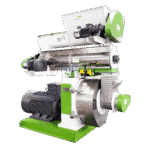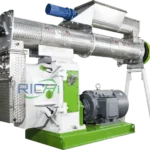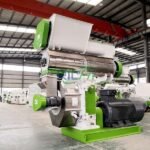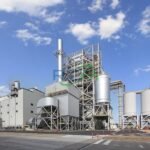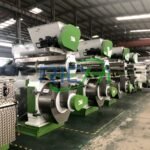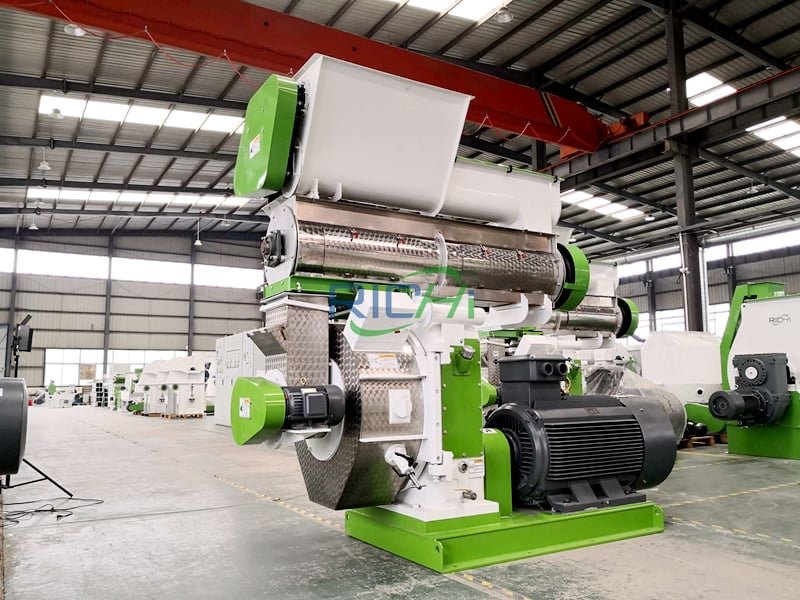Introduction
Sustainability has become a defining concern across all industries, and agriculture is no exception. In poultry farming, feed production is a major contributor to environmental footprints, accounting for significant portions of energy use, greenhouse gas emissions, and resource consumption. However, the adoption of poultry feed pellet machines can shift this narrative, enabling more sustainable, efficient, and responsible poultry operations.
This article delves into how poultry feed pellet machines contribute to environmental conservation and sustainability. From reducing feed waste and optimizing resource usage to enabling circular economy models, we explore how this technology aligns with global goals for green agriculture.
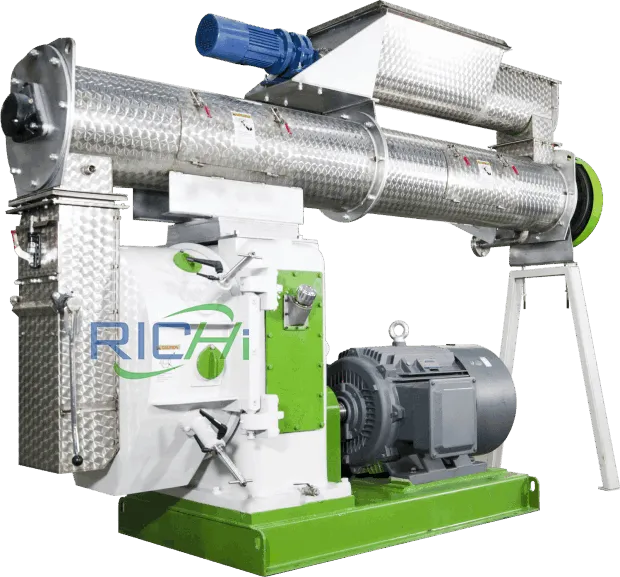
1. Environmental Challenges in Conventional Poultry Feed Production
Poultry feed production, particularly in traditional or industrial setups, presents several ecological issues:
- Resource-intensive operations: Large quantities of grains, water, and energy are used.
- Transportation emissions: Sourcing and delivering feed long distances adds CO₂ output.
- Excess packaging and waste: Commercial feed often comes with plastic packaging, contributing to landfills.
- Spoilage and feed waste: Improper storage and bulk handling can lead to feed losses.
- Land degradation: High demand for feed grains leads to monocultures and over-farming.
By localizing feed production and improving feed efficiency, pelletizing technology offers a more sustainable alternative.
2. How Poultry Feed Pellet Machines Reduce Environmental Impact
A. Minimizing Feed Waste
Pelletized feed is compact, uniform, and less prone to spillage. Unlike mash or crumble, pellets:
- Resist separation of ingredients
- Reduce dust generation
- Are easier for birds to peck and consume entirely
Impact: Less waste means fewer raw materials used per kilogram of meat or eggs produced, leading to lower overall agricultural input requirements.
B. Improved Feed Conversion Ratio (FCR)
A lower FCR means birds grow more efficiently on less feed. Pellets help achieve this through:
- Better digestibility
- Enhanced nutrient density
- Controlled intake rates
Improved FCR translates into less crop production for feed, lower land use, and fewer emissions per unit of poultry product.
C. Energy Optimization in Production
Modern poultry feed pellet machines feature:
- High-efficiency motors
- Variable frequency drives (VFDs)
- Steam integration for conditioning
- Automated controls to avoid overuse of energy
Using local biomass boilers for steam generation can further reduce fossil fuel reliance.
3. Enabling Circular Agriculture Models
Poultry feed pellet machines make it easier to incorporate agricultural and food industry byproducts into feed. Examples include:
| Byproduct Source | Feed Ingredient Potential |
|---|---|
| Rice mills | Rice bran, broken rice |
| Oilseed processors | Soybean meal, cottonseed cake |
| Breweries | Spent grain, yeast residues |
| Vegetable processors | Carrot pulp, beet pulp, cabbage waste |
| Meat processing plants | Blood meal, bone meal |
Pelletizing stabilizes and homogenizes these diverse materials, making them suitable for poultry consumption.
Environmental Impact:
- Diverts food waste from landfills
- Reduces methane emissions from decomposition
- Promotes circular economies and closed-loop systems
4. Reducing Transportation Emissions
Sourcing feed from distant suppliers involves high logistical costs and carbon emissions. A poultry farm with its own pelletizing capacity can:
- Use local raw materials
- Avoid long-distance transportation of bulky feed
- Reduce dependency on diesel trucks and supply chain intermediaries
Example:
- A 10,000-bird farm purchasing 1.5 tons of feed daily saves ~20,000 km of truck travel annually by localizing feed production—cutting roughly 15–20 metric tons of CO₂ emissions per year.
5. Supporting Regenerative Agriculture
Pellet machines support regenerative farming by:
- Allowing the use of cover crops and rotational crops in feed (e.g., legumes)
- Integrating livestock and crop production cycles
- Using composted manure in crop production, then recycling crops into feed
- Encouraging on-farm feed formulation and nutrient circularity
These practices help:
- Restore soil health
- Reduce chemical input dependency
- Increase biodiversity
- Lock carbon into the soil
6. Water Conservation
While water is not a major input during the pelletizing process, the indirect savings are significant. By improving FCR and incorporating low-water crops and byproducts, pelletizing:
- Reduces irrigation needs in feed crop production
- Minimizes water use per kilogram of poultry output
- Helps farms meet water efficiency targets
Some pellet machines also use steam instead of water for conditioning, improving energy balance without excessive water use.
7. Sustainable Packaging and Storage
Pelletized feed can be stored in bulk silos or reusable containers, reducing reliance on plastic sacks. This:
- Reduces landfill-bound packaging waste
- Enhances feed shelf-life (less spoilage = less waste)
- Supports warehouse automation for inventory control
Smaller farms can also bag pellets in compostable or recyclable sacks, especially when selling locally, supporting low-waste distribution.
8. Renewable Energy Integration
Modern feed mills, including pellet machines, can be paired with renewable energy systems, such as:
- Solar panels to power electric motors
- Biomass boilers for steam conditioning
- Biogas systems from poultry manure to supplement energy supply
This minimizes fossil fuel reliance and supports net-zero carbon emission goals.
9. Compliance with Green Standards and Certifications
Many countries now have sustainability certification programs for poultry producers. Pellet machines help farms meet the following criteria:
| Certification Standard | Relevant Sustainable Practice |
|---|---|
| GlobalG.A.P. | Feed safety, traceability, waste minimization |
| USDA Organic / EU Organic | Non-GMO feed, local ingredient sourcing |
| ISO 14001 (Environmental) | Resource efficiency, pollution control |
| LEAF (Linking Environment & Farming) | Integrated farm management, nutrient cycles |
Producing your own feed with a pellet machine provides greater control over sourcing, traceability, and compliance.
10. Educational and Community Impact
Larger poultry operations with pellet machines can extend their environmental influence by:
- Educating surrounding farmers on feed efficiency
- Offering contract pelletizing services to reduce waste
- Building cooperatives for shared feed production
- Demonstrating low-emission, high-efficiency practices
This creates a ripple effect, driving broader sustainable development in the region.
11. Government Incentives and Support
Many governments support sustainable agriculture with:
- Grants for renewable energy integration
- Tax credits for sustainable capital investment
- Subsidies for pollution control equipment
- Low-interest green loans for feed mills
- Technical support for clean feed formulations
By aligning feed production with national or regional sustainability goals, farms become eligible for a wide range of financial support.
12. The Role of Pellet Machines in Climate Change Mitigation
Climate-conscious poultry farms are increasingly investing in climate-smart technologies. Pellet machines contribute by:
- Reducing CO₂ emissions via transport minimization
- Decreasing methane emissions from decomposing organic waste
- Improving carbon intensity per kg of poultry product
- Supporting soil carbon sequestration through regenerative feed sources
Carbon accounting tools can be used to quantify emission reductions, supporting carbon credit applications or sustainability reports.
13. Future Trends: AI and Smart Feed Systems
The next generation of poultry feed pellet machines will include:
- IoT sensors for real-time monitoring
- AI algorithms for optimizing formulations
- Blockchain integration for feed traceability
- Remote diagnostics and predictive maintenance
These upgrades will make feed production even more resource-efficient, traceable, and aligned with global sustainability targets.
Conclusion
Sustainability in poultry farming requires systemic changes—starting with feed, the largest input and environmental footprint contributor. Poultry feed pellet machines represent a pivotal technology in this transformation. By reducing waste, enhancing efficiency, supporting local sourcing, and enabling circular resource use, pelletizing feed helps farms align with environmental goals while improving profitability.
Whether your goal is to meet carbon-neutral targets, reduce operating costs, or build a brand rooted in sustainability, investing in a poultry feed pellet machine is a smart, future-ready move.
